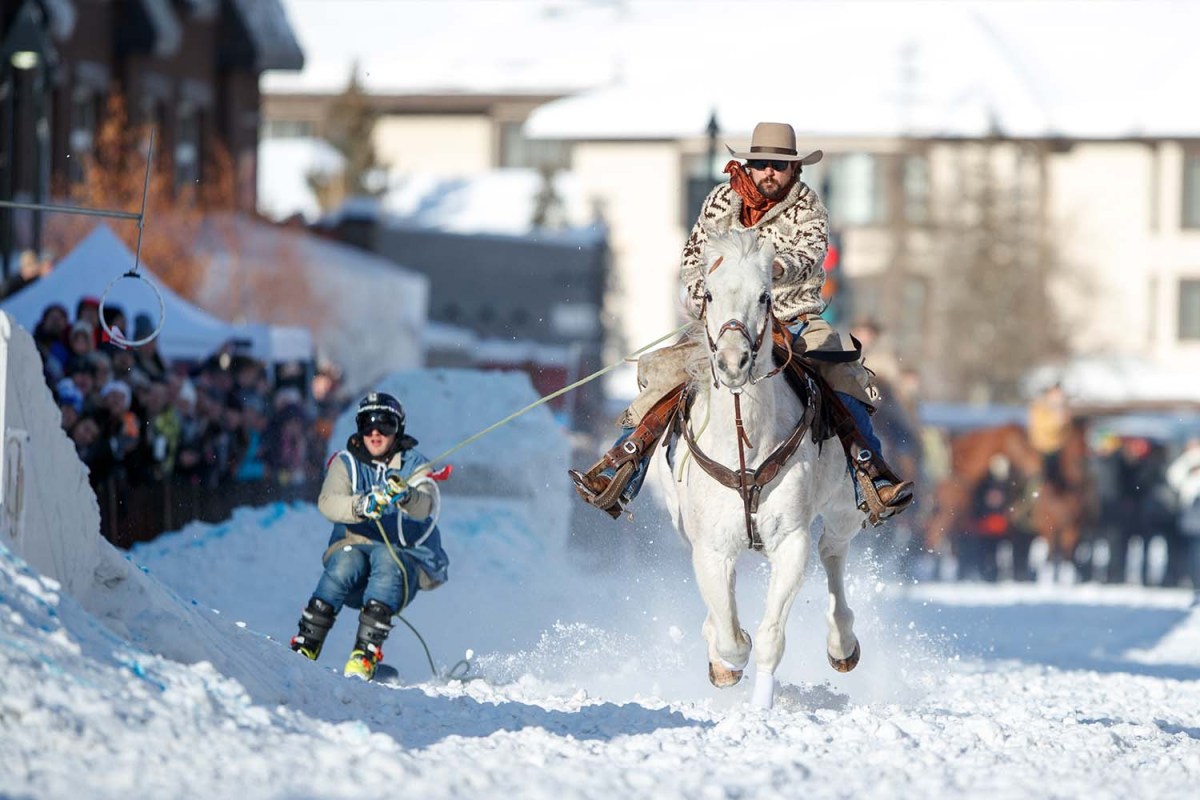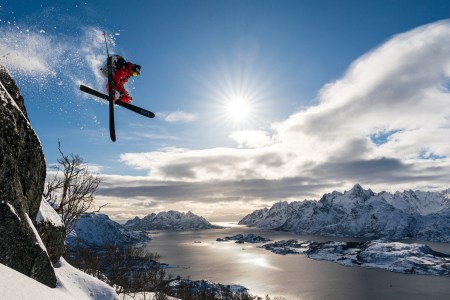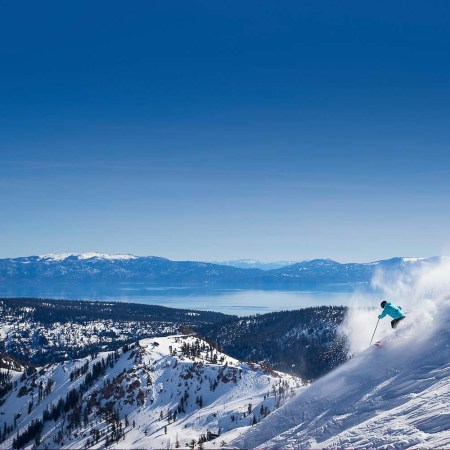In the wildest show on snow, equestrian skijoring puts carving skiers and galloping horses together for the fastest-growing winter sport in North America.
Snow flies from pounding hooves. Riders on retired race horses pull rope-clutching skiers down a 700-to-900-foot track at speeds up to 40 mph. Skiers tackle jumps and edge around gates to grab for suspended rings in front of cheering spectators just a few feet from the action.
It’s a mixed-gender sport. Men and women compete equally as riders and sliders — the term for skiers and snowboarders — in timed sprints, circuits, relays and long jump events. For switcheroo races, equestrians and skiers swap places at the turn.
Skijoring, or ski joring (Norwegian for “ski driving”) has a long history in Scandinavia and among the northern Sami people, who have used reindeer to tow people on skis for centuries. Equine skijoring, where a skier steers a riderless horse with a pair of reigns, has been popular at European ski resorts for more than 100 years.
In the early 1900s, the sport came to winter carnivals in the U.S. and Canada. While skijorers can be pulled by dogs, motorcycles, snowmobiles, you name it, the authentic horsepower factor makes the sport a real thrill.
Skiers and snowboarders choke up and ease off on the rope to time turns and hit jumps. It feels more like waterskiing than a snow sport at times, participants say. In American skijoring, the rope is attached to the raised back of the saddle, called the cantle, by a carabiner. The Canadians dally the rope by wrapping it around the saddle horn.
The adrenaline rush of the race, the beauty of the horses and the competitive skills of riders and sliders makes skijoring Loren Zhimanskova’s idea of a great winter event. She is the founder and president of Skijor USA and Skijor International — and has an encyclopedic knowledge of skijoring history and a love for the sport she first saw in 2012.
Wrapped up in the excitement is a romantic element with a nod to the old West. And it is skijoring’s blend of ski and horse culture that competitor Matt Monod finds irresistible. Monod grew up in the legendary Canadian ski town of Banff, Alberta. A local ski star, he was a teenage member of the provincial ski team and is part owner of multi-generation family outdoor outfitter business, Monod Sports. Monod says he was so star struck by the skilled horses and riders, he started riding in the off season. “I felt like I was with pros. You know what I mean? I don’t care what you’re doing, if you’re good at something, I have a lot of respect for you,” he says.
Chasing Fresh Powder and True Adventure Above the Arctic Circle
Everything you need to know about backcountry skiing in NorwayMonod is also very good at skijoring. He was part of a demonstration event down Banff’s main street at the SnowDays Festival in 2020, where he popped thrilling back flips off jumps. Monod also joined 16 Skijor Canada teams on Jan. 28 at SnowDays 2023. The action included Roman riding, where a trick performer stood astride two galloping horses while towing a skier.
“When you’re there, just having that horse thunder by you and then that sound of the skis carving and the smack after a jump and you just can’t help but get excited. There’s something beautiful about it and it’s just so dramatic,” says rider and horse trainer Sam Mitchell, CEO of Skijor Canada who organizes the Banff event.
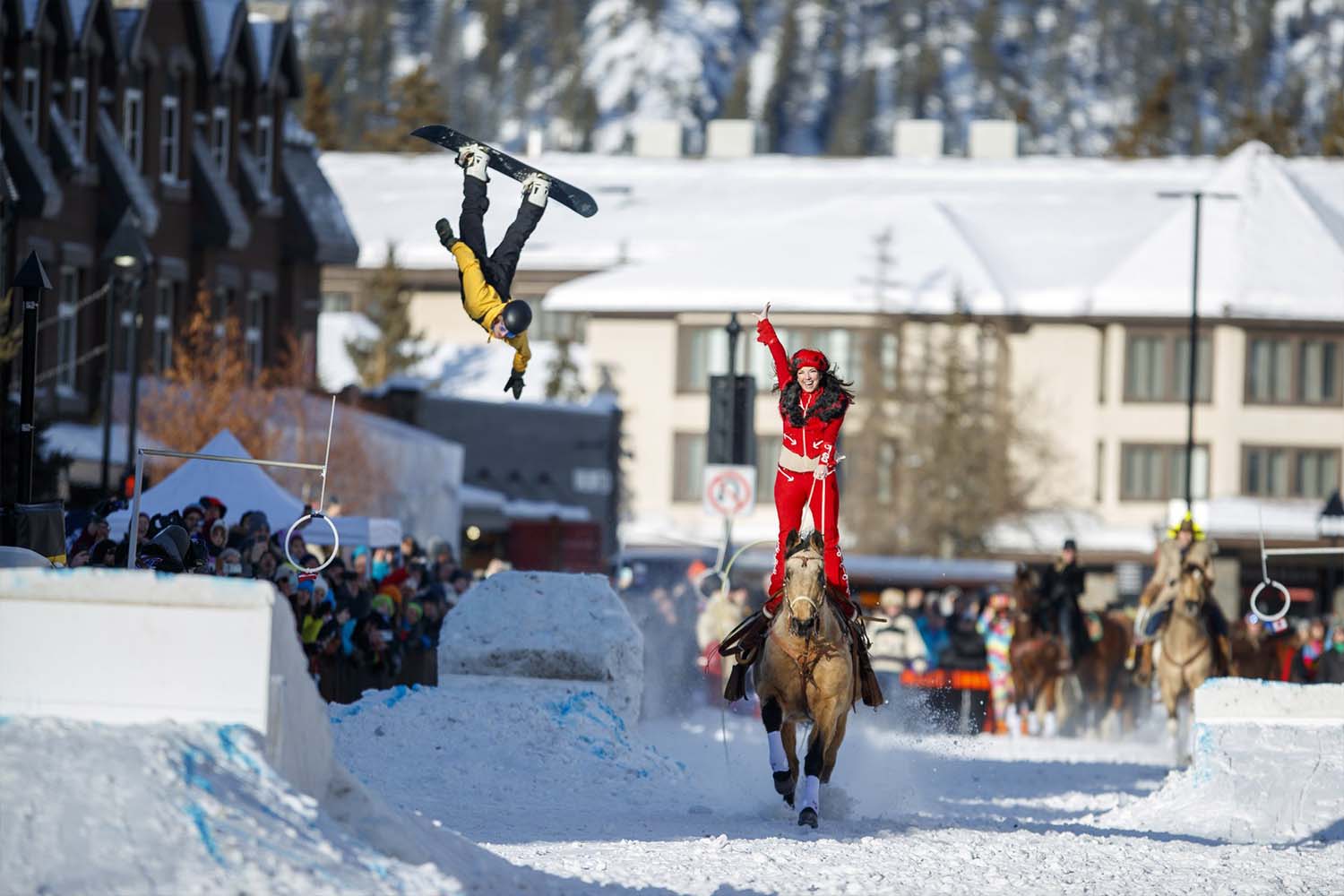
“If you like horses and you’re competitive, it really kind of hits you up, hits you hard. So yeah, it is definitely just something else that gets in your blood,” says skijor rider and Montana hunting outfitter Josh Abbott. He drove 12 hours from his ranch outside Bozeman, Montana to Meeker, Colorado, trailering bay horse Reb and red sorrel Elvis for his most recent skijoring event.
Horse-lover Abbott has been skijoring for nearly 10 years. He met his future wife, Amanda, also a skijoring rider, at an event in 2016. He’s ridden several times in Leadville, Colo., where the amped-up version of competitive skijoring was born in the late 1940s.
The historic former silver mining town marks the 75th running of Leadville Ski Joring in March, where spectators typically line Harrison Avenue five deep to cheer for horses, riders and sliders.
“I think the skiers are crazy for grabbing onto a rope that’s tied onto a horse myself, but I honestly appreciate what they do,” Abbott says.
Horse safety is top priority, says Zhimanskova. The snow on the track is kept a uniform four-to-six inches deep. The race area is groomed and checked for dips or imperfections that could injure a horse. Skiers and riders do inspection walks before the event. A veterinarian is on site.
Abbott says horses are given a lengthy runout at the finish to avoid quick stops. They run in special ice shoes, or a borium coating made with slip-resistant crystals is applied to shoes. They also wear poppers, pads that keep the snow out of their feet.
The horses are just as keen to compete as the riders and sliders.
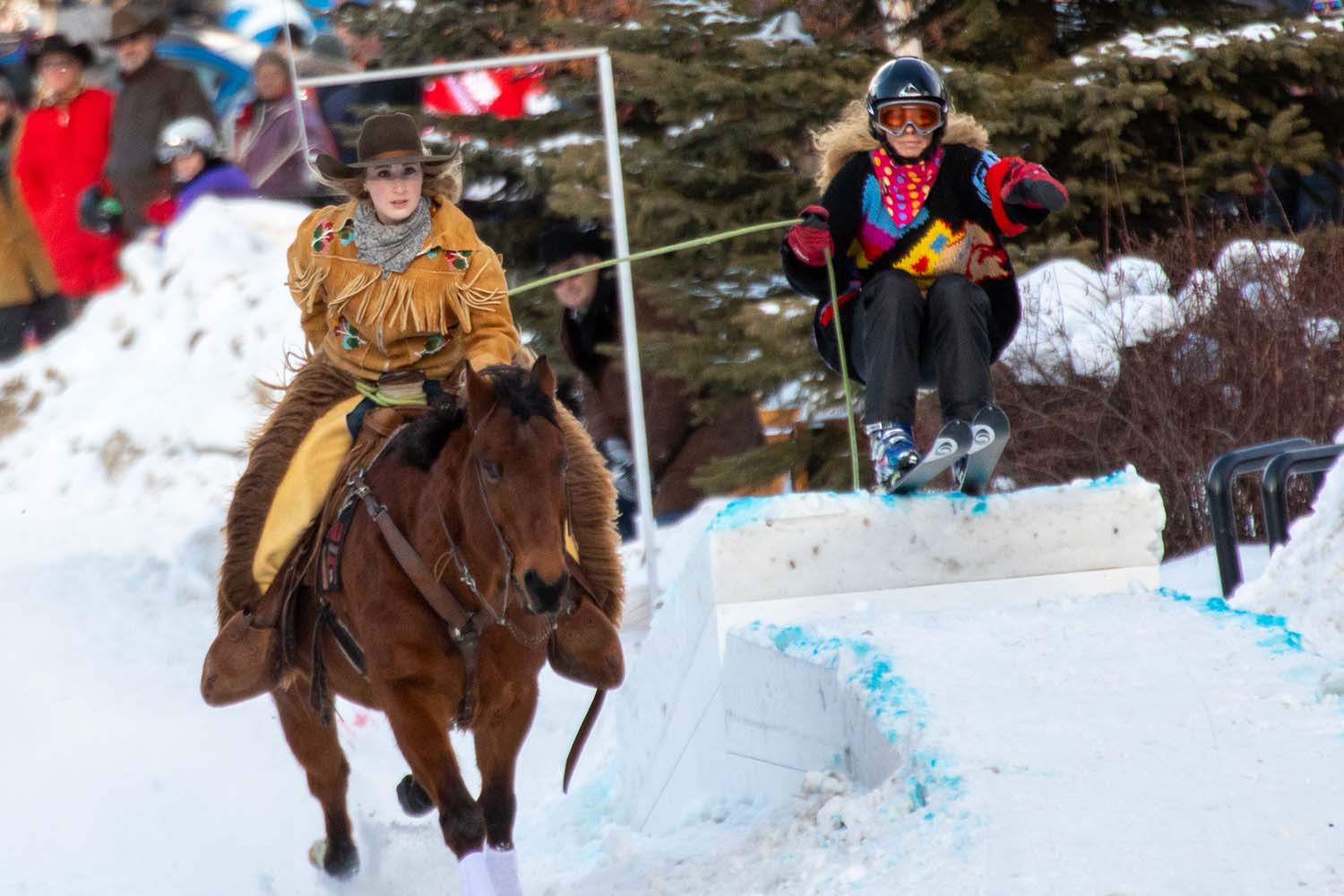
“Oh, they absolutely love it,” said Zhimanskova. “The people that own the horses say that their horses anticipate this. They know in the winter months when they’re being trailered to an event and they see all the activity. They absolutely know what they’re about to be doing and they love it.”
Then there’s the outrageous blend of Western wear, vintage fashions and slope styles worn by participants and fans. Add tailgating (horse-trailer gaiting?) and food and beverage stations and skijoring is a party.
Zhimanskova sees a great opportunity with the Western-meets-alpine fashion element of the sport. With a background in fashion and photography, she’s done sales and marketing plans for Ralph Lauren, the designer who turned millions of people with only vague notions of polo into pony logo-wearing devotees.
She says this is skijoring’s time to enter the mainstream sports arena. The Western lifestyle is hot, with TV series Yellowstone putting a spotlight on cowboy and rodeo culture. Extreme sports are always a draw.
“I love the juxtaposition of old Western and really modern techie ski gear and those woolly chaps and leather fringe and sleek technical fabrics and the reflective goggles,” Mitchell says.
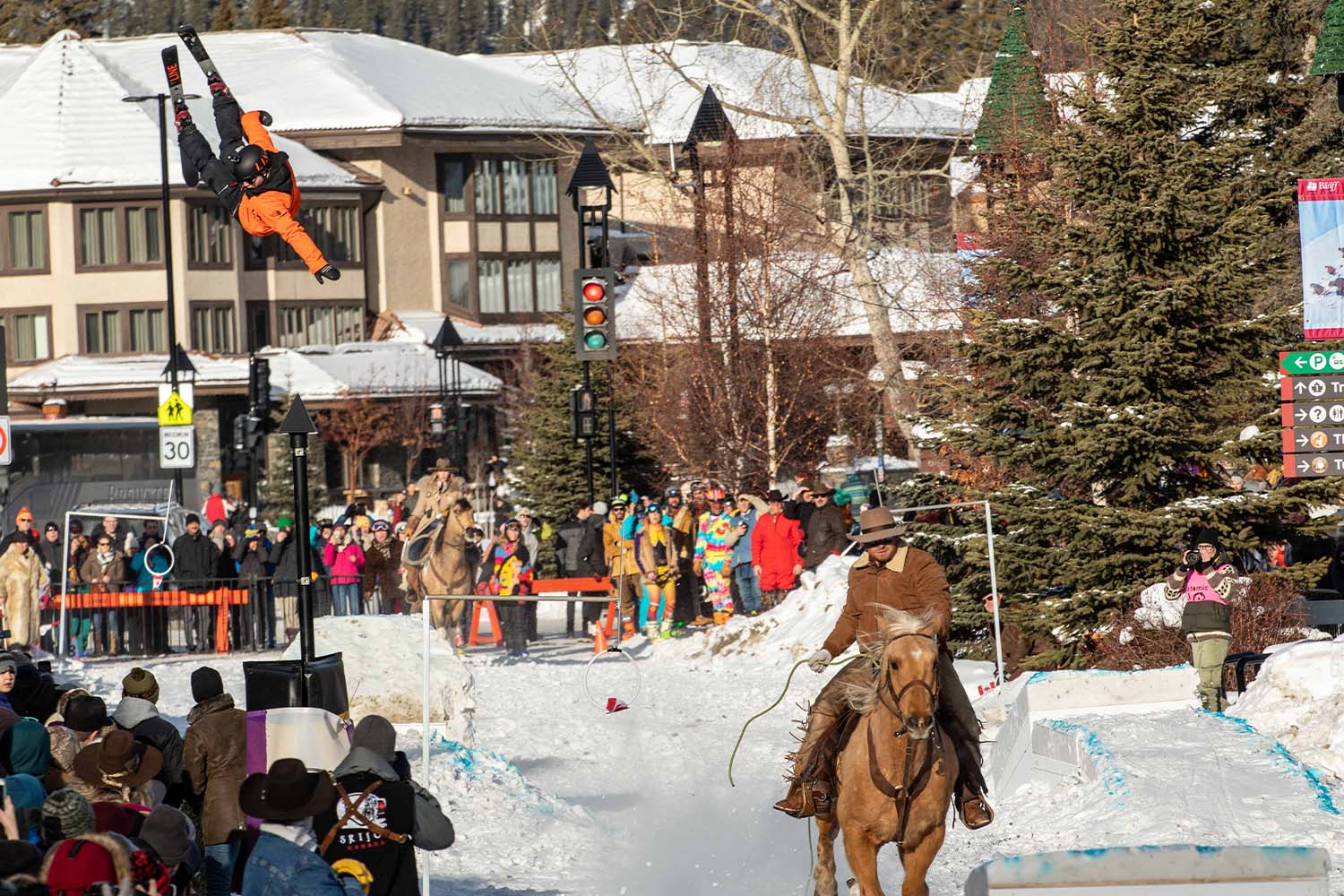
In 2016, Mitchell came up with the idea for Skijordue, a mash-up of skijoring and fondue with the motto “eat cheese go fast.” She invited a handful of friends and put out calls for cowboys, cowgirls and skiers for the inaugural Skijordue.
“It was the most unlikely pairing of, like, crunchy old stunt riders and pickup men and ranchers and these hotshot ski park rats and they were so suspicious of each other coming in,” says Mitchell. “They came back from their first round just like absolutely grinning.”
The open-space venue of the Calgary Polo Club allows five or six horses and sliders to run abreast at a time.
She’s expecting more than 4,000 people for Skijordue 23. Teams from as far away as Japan are interested in competing. In 2020, an Irish team won the sprint division.
Skijoring is also moving east. Ted Slathar, who organizes professional rodeo events with his company Extreme Events MN, started skijoring events at Canterbury Park race track, about 20 miles outside Minneapolis-Saint Paul, Minnestota in 2017. About 10,000 people showed up in 2020. Within a day of opening registration for next month’s skijoring event, 200 people had already signed up.
Two teams race together against the clock at Cantebury. There’s also a freestyle class that crowds love, along with novice and pee wee divisions.
“It gives something for the crowd to watch and the team to cheer for,” says Slathar, who would like to see the sport grow.
Skijoring was an exhibition sport at the 1928 Winter Olympic Games in St. Moritz, Switzerland. There’s talk among skijor enthusiasts that if the Games are awarded to Salt Lake City, Utah in 2030 or 2034, they hope to see it as a demonstration sport or at the opening ceremonies.
“I love the idea of having it as part of a torch relay,” says Zhimanskova.
Whether you’re looking to get into shape, or just get out of a funk, The Charge has got you covered. Sign up for our new wellness newsletter today.
